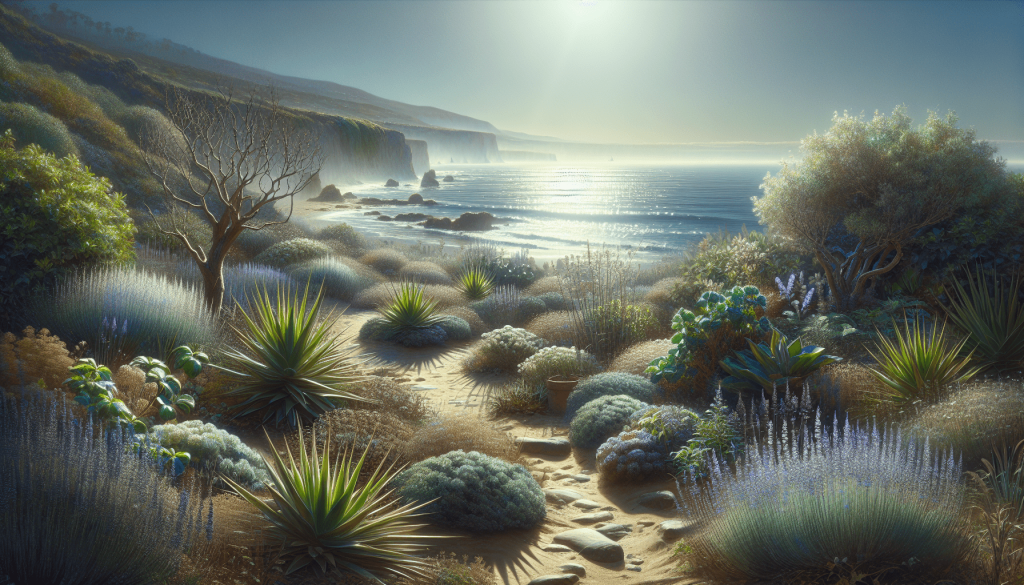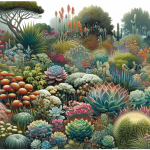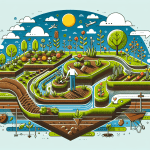This post may contain affiliate links. As an Amazon Associate, we may earn commissions from qualifying purchases.
Have you ever found yourself strolling along a coastal path, captivated by the unique plants that thrive even in the salty, windy conditions, and wondered what makes them so special? Coastal gardening presents a beautiful yet challenging landscape canvas for the green-thumbed among us. The allure of the sea breeze, the crashing waves, and the serene views are undoubtedly appealing. However, selecting the right plants requires careful consideration.
What Are The Key Factors In Selecting Plants For A Coastal Garden?
Choosing the right plants for a coastal garden is not exactly about throwing a few seeds on the ground and waiting for magic to happen. Salt, wind, sand, and the occasional hurricane can turn gardening into something akin to an Olympic sport. But don’t worry, it’s not as daunting as it seems. Let’s break this down and throw in a dose of humor. Imagine you’re a plant; how would you survive and thrive in these challenging conditions?
Understanding Coastal Conditions
Before you choose your flora, understanding the unique coastal conditions is essential. It’s like getting to know the weather before packing for a vacation—no one enjoys wearing a parka in a heatwave.
Salinity
Salt: a crucial component for margaritas and oceanic ambience, but a real stressor for plants. Plants in coastal regions face saline soils and salt spray. Some plants handle salt better—like a veteran sailor who’s been around the world twice—and these are your go-to options.
Wind
Wind can be both a friend and an adversary. On one hand, it keeps pests away and helps in pollination. On the other hand, it can damage delicate plants and dry out soil. Wind-resistant plants are your garden warriors, standing firm against gusty adversities.
Soil Quality
You might be imagining beach sand sprinkled with fertilizer—but coastal soils vary. From sandy and loose to heavy and clay-like, understanding your soil type helps in picking plants that can root deeply and withstand soil-specific challenges.
| Soil Type | Characteristics | Ideal Plants |
|---|---|---|
| Sandy | Well-drained, low in nutrients | Beach grasses, succulent varieties |
| Clay | Heavy, retains moisture | Thyme, rosemary, lavender |
| Loamy | Ideal mix of sand, silt, clay | Herbs, many perennials, shrubs |
Salt Spray
Those refreshing sea breezes bring salt, which can settle on foliage and soil. Plants need to withstand constant leaf wash and salt deposition. Picture going to a beach and not minding the sand in your shoes—some plants are just that tolerant.
Temperature Fluctuations
Temperature can swing more wildly than a soap opera plot. From hot and sunscreen-needing to cool enough for a jacket, plants should be hardy to handle these changes without throwing a fit (or wilting dramatically).
Plant Characteristics to Look For
Now that you are cozy with the coastal conditions, let’s talk plant traits. Imagine organizing a team for an intense relay race. You wouldn’t pick someone who faints at the first sign of exertion, would you?
Salt Tolerance
Plants that can handle salty environments without getting all ‘salty’ are essential. These include a mix of succulents, certain grasses, and hardy shrubs.
Wind Resistance
Picking plants with sturdy stems and flexible branches that can bend rather than break is key. Think of those iconic seaside pines or robust, sturdy bushes.
Drought Tolerance
Not all coastal areas receive frequent rain. Choosing plants that need minimal water and have deep root systems like succulents, cacti, and certain drought-resistant shrubs can make life easier for both you and your garden.
Native Adaptation
Plants native to coastal areas have already adapted to these harsh conditions. They’ve been through the botanical equivalent of boot camp and survived. Why not harness their hard-earned resilience?

Recommended Coastal Plants
Your selection of plants is crucial for a garden that’s not only beautiful but also sustainable. Let’s break down some reliable stars for coastal gardening.
Perennials
Perennials that come back year after year without you needing to fuss over them are, to put it mildly, the dream. They’re like that helpful friend who always remembers your birthday.
Lavender (Lavandula)
Lavender is like the calm, wise grandparent of the garden. It’s fragrant, hardy, and remains unbothered by salty soil.
Advantages:
- Salt-tolerant
- Drought-resistant
- Attracts pollinators
Thyme (Thymus)
Thyme is versatile, low-growing, and can be used in your cooking, making it both garden-friendly and kitchen-friendly.
Advantages:
- Hardy and resilient
- Can grow in poor soil conditions
- Low maintenance
Grasses
Grasses offer movement and texture. Their ability to sway and bend with the wind gives your garden a dynamic, almost poetic quality.
Beach Grass (Ammophila breviligulata)
As the name suggests, this grass is your go-to for stabilization and appeal.
Advantages:
- Strong root systems for erosion control
- Drought and salt-tolerant
- Can grow in sandy soils
Shrubs
Shrubs provide structure and are often more resilient than their delicate, herbaceous counterparts.
Rosemary (Rosmarinus officinalis)
This aromatic herb is not just for your roast chicken. It’s sturdy, evergreen, and a visual treat.
Advantages:
- Wind and salt-tolerant
- Hardy and drought-resistant
- Can grow in poor soils
Design Tips for a Coastal Garden
Beyond plant selection, the layout and design matter. This is where you get to play garden designer, making sure everything not only survives but looks Instagram-ready.
Windbreaks
Create natural windbreaks with strategically placed shrubs and trees. Think of them as the big bouncers standing guard outside your favorite club, letting in only the breeze and keeping out the gale.
| Windbreak Plant | Ideal For | Placement Tips |
|---|---|---|
| Pine Trees | Tall, dense coverage | Perimeter of the garden |
| Olearia | Shrubby coverage | Scatter throughout, layer with other plants |
Mulching
Use mulching to retain moisture and enrich your soil. Mulch, bless its earthy little heart, can be made from a variety of materials:
- Organic Mulch (Compost, Bark Chips): Adds nutrients, improves soil structure.
- Inorganic Mulch (Pebbles, Gravel): Prevents weed growth, excellent drainage.
Raised Beds
Raised beds can help manage easily blown sand and solve drainage issues. They are the garden beds on stilts—keeping everything organized and sustainable.
- Material Choices: Treated wood, stone, recycled plastic.
- Height and Width: Typically around 12-18 inches high and 3-4 feet wide.
Pathways
Construct pathways with permeable materials to handle the occasional splash of heavy rain or salt spray. Gravel, pebbles, and even seashells make creative, functional pathways.
Maintenance Tips and Tricks
You have your coastal garden dreaming in shades of blues and greens; now, maintaining it is like occasionally watering a houseplant and hoping it doesn’t get too moody.
Watering Wisely
Even drought-tolerant plants need a drink now and then. Ensure you:
- Water Early in the Morning: Reduces evaporation.
- Deep Watering: Encourages deeper root growth.
- Use Drip Irrigation: Efficient and conserves water.
Pruning and Trimming
Regular pruning encourages healthy growth and keeps plants from looking like they got into a boxing match with the wind:
- Remove Dead or Damaged Parts: Prevent infections.
- Shape Shrubs and Trees: Helps them grow more robust and wind-resistant.
Checking for Pests and Diseases
Salt and wind typically keep invasions at bay, but be vigilant. Inspect plants regularly for signs of distress:
- Discoloration: Could indicate nutrient deficiency.
- Holes or Chew Marks: Likely pests.
- Fungal Growth: Due to poor drainage or overcrowding.
Sustainability Practices
Your coastal garden can be an eco-haven with a few sustainable tweaks. Trust me, the planet will give you a high-five.
Native Plants
Go native or go home. Native plants are already adapted to local conditions, require less water, and support local wildlife.
Composting
Create a simple composting system to recycle garden waste. This turns your old foliage and kitchen scraps into rich, nutrient-laden soil amendment.
Water Conservation Techniques
Install rain barrels to collect and reuse rainwater. Use greywater systems for irrigating non-edible plants.
Eco-friendly Pest Control
Use natural pest deterrents like neem oil or introduce beneficial insects. Marigolds, garlic, and chrysanthemums work wonders as natural bug repellents.
Climate Considerations
Lastly, think about the broader climate patterns and how they affect your coastal garden. Remember, climate change is the guest no one invited, but it’s here to stay:
Rising Sea Levels
Sea levels are rising faster than a loaf of bread in a hot oven. Ensure good drainage, use raised beds, and select flood-tolerant plants.
Extreme Weather Events
Extreme weather is generally brought about by changes in atmospheric pressure and sea temperatures, making storms more intense. Invest in strong structures and plant windbreaks.
Temperature Variability
Create microclimates in your garden by using rockeries, small water bodies, and shaded areas. This helps buffer the extremes and protect more delicate plants.
Wrapping Up
Coastal gardening may have its challenges, but the rewards are outstanding. With the right plants and a well-thought-out design, your garden will be a testament to nature’s resilience and beauty. So, take a leap, get your hands dirty (metaphorically speaking, unless you’re actually planting right now), and create a coastal garden that would make the mermaids envious.
If you’re ever unsure, just remember: if a plant can survive wind, salt, and sand without complaining, it’s pretty much a superhero in the plant kingdom. Now, time to let your coastal garden dreams set sail.








